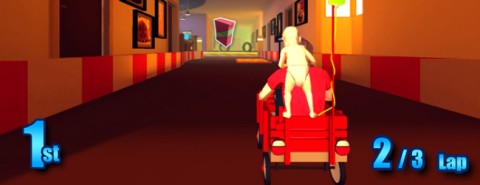A game you can’t win

In his book Lament for a Son, about the death of his 25-year-old son, Nicholas Wolterstorff invited readers to “sit beside me on my mourning bench.” In the video game That Dragon, Cancer, Ryan and Amy Green take us with them as they care, pray, and grieve for their five-year-old son, Joel, who is dying of cancer. As Wired and the Washington Post have noted, this ruthlessly honest video game breaks new ground in the culture of gaming, in which having fun has been the main goal.
The game shepherds the player through stages in Joel’s cancer and the Greens’ caregiving. It moves between a playground, a hospital room, and several surreal landscapes. The player assumes the role of Ryan, Amy, or Joel.
The game’s title comes from a scene that uses imagery from 1980s arcade games. The Greens explain cancer to Joel’s siblings by comparing cancer to a dragon. The player then uses keyboard keys to dodge the dragon’s fireballs or leap over pits. The absurdity of the play manages to lighten the somberness of the experience while underscoring the seriousness.
Read our latest issue or browse back issues.
Ryan and Amy Green provide their own voices, and Joel’s delightful giggling was recorded prior to his death. But although the voices are authentic, the design style is often abstract; faces, for example, lack eyes and other features.
Prayers used in a cathedral setting are recordings of the prayers offered by the Greens and their friends during Joel’s last hours of life. This element seems creepy, yet the prayers break new ground for creativity in gaming technology. The recordings serve as a kind of digital remembering, taking us back to a sacred moment in this family’s life together.
Playing Dragon requires that the player make choices and take action. In this interactive mode, the Greens’ story becomes the player’s story.
Actual gameplay is simple: the player navigates through a public park or a cancer ward and interacts with objects or people by moving the mouse. He proceeds at his own pace, exploring rooms, perhaps stopping in the cancer ward to read cards written by Kickstarter donors in honor of family members who had cancer—another example of how this video game blurs the distinction between gaming and the real world.
The player’s decisions parallel those that Joel’s parents must make. In one segment, the player suddenly finds himself awakened in a hospital room chair, holding Joel on his shoulder. The medicine dispenser connected to Joel is beeping, and the player must find a way to turn the sound off. The game recreates the panic of frantically pushing buttons so as not to awaken a sleeping child.
In another chapter, the game recreates childhood delight. For reasons the Greens never understood, Joel actually enjoyed his radiation treatments (most children fear the ominous machinery). In the game, the radiation process includes a fantasy of Joel riding stars that take the form of animal constellations. The player’s actions make Joel laugh or send him down a playground slide. It’s as if the player is helping this dying child experience a moment of happiness.
Yet the player also must experience loss of agency. One of the most difficult chapters takes place in the cathedral setting where the player hears the sound of praying. There is a small, one-octave keyboard with lighted candles around it. In most games this setting would present a puzzle—by lighting the candles in a certain sequence and interacting with the keyboard in the proper way, the player would advance to the next level. But in Dragon, nothing the player does makes a difference; he cannot control the outcome.
As scholars of gaming note, a video game encodes its own parameters for playing and winning and creates a metaphysics for its particular universe. Some games are pleasing because we enter a universe where we can defeat the dragon and act as savior. Dragon is unique in offering us the experience of our own powerlessness.
The Greens reminds us that although we are powerless, we are not helpless or hopeless. They struggle and doubt but remain faithful. Creating this game helped them through their loss and became a vehicle of hope. They believe that it can help users grow in compassion and empathy by increasing their capacity to be with those who suffer.
Christian gamers report that they cried or prayed as they “sat” next to the Greens in the doctor’s office or played a game with Joel. As Wolterstorff wrote, “To comfort me, you have to come close.” It seems strange, but users of this game do just that.
Some gamers have posted an antagonistic message or asked for their money back because Dragon was not the kind of video game they expected. But most reviewers and online commenters respect the Greens for their refusal to accept simplistic “Jesus makes everything OK” answers. They value the acknowledgment of their own spiritual uncertainties, and they value the Green’s respect for their interest in gaming.





